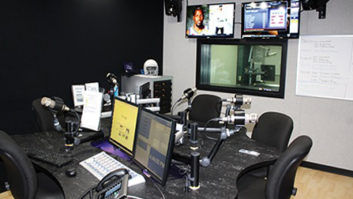
The Stortingsbygningen Norwegian Parliament Building. Photo by Dmitry Valberg (CC BY 2.0)
OSLO — Technological advancements are sometimes able to turn long-running (but still reliable) items or standards into outdated legacies. Usually, it’s the market that decides.
When it comes to broadcasting standards this can be different. Digital terrestrial television started as a voluntary, redundant process and today most countries worldwide have embraced the idea to switch-off their existing analog television broadcasts, replacing them with digital. The basic idea behind this migration is both to widen the consumers’ choice by adding new channels and to free up spectrum for use by mobile telecom operators.
As for radio, until recently there were no firm statements from any government regarding the switch-off of FM broadcasts.

Thorhild Widvey is Norway’s Minister
of Culture. Photo by Thomas
Haugersveen/Statsministerens kontor
Thorhild Widvey, Norway’s Minister of Culture, shook things up in April, when she announced that the government set 2017 as the date “for the switch-off of Norway’s FM radio stations.” About 200 local stations, mainly located in small towns and villages around the country, will nevertheless remain on FM for at least five more years, both to avoid extra costs on the stations and to guarantee regional content.
CONSUMERS’ POINT OF VIEW
From the consumers’ point of view, Ann Hege Skogly, senior communications adviser at Forbrukerrådet, the Consumer Council of Norway, explained that consumers need to be prepared and informed.
“Our concerns were the consumers’ predictability and safeguarding their rights. We don’t hold technical expertise so we didn’t participate in that discussion. Our concern is that the consumer is well informed about the process,” she said. “The store must inform the client that FM receivers will only receive smaller local radio stations after switch-off. If you now buy an FM radio, and you don’t receive this information, then you have a reason to complain.”
In neighboring Sweden, Riksrevisionen, the National Audit Office, presented a report to the parliament in April warning of possible dangers in transferring to digital radio. According to the report, the planned transition to terrestrial digital radio is “associated with considerable risks, because the government’s preparations for the transition are inadequate; there is no clear listener perspective; there are deficiencies in the technical assessments; and the transfer is probably not cost-effective for the national economy.”
Furthermore, several public institutions and many radio stakeholders in Sweden answered a public consultation promoted by the country’s Ministry of Culture, and no agreement was found about the digital transition.
According to Nina Wormbs, associate professor at the Swedish Royal Institute for Technology and government adviser, “The consultation confirmed the various positions already expressed in the past, with no noticeable new elements, other than an exception made for the possible need of managing a limited spectrum overlap between some Band III frequencies used for DAB radio and some military equipment.”

Nina Wormbs is the Associate Professor at the Swedish Royal
Institute for Technology. Photo by Peter Mac Avock
Wormbs said that the discussion about the transition from FM to digital radio is currently a hot one in Sweden, but people are just talking about technology, guessing about which could be the best-performing standard.
MEDIA POLICIES AND DEMOCRACY
“There is no ultimate and final standard,” Wormbs added. “From time to time a new standard or codec appears and supersedes the previous one. There is more to this than just technology and standards. I believe that we should think of the national media policy too.”
Wormbs said that many people listen to Internet radio but they don’t think about how the content is reaching them. “If we follow the Internet trend and choose to deliver everything via the Web, everything would be flowing through a single platform. I see a potential problem of democracy in this.”
Last week, the Swedish government announced that it is delaying its planned switch from FM to digital DAB+ broadcasting. According to the Swedish Minister for Culture and Democracy Alice Bah Kuhnke, there isn’t enough support to justify a transition to digital at this point in time.
“The government’s view is that our present radio solution, the FM network, is not vitiated by such defects that a move (to DAB+) is justified,” said Kuhnke in an article published in Svenska Dagbladet. “The future of radio is central to our whole society… The government will now follow the trend for the future of radio listening vigilantly and will continue to be careful to have broad parliamentary support for media policy.”
Finland launched DAB in 1998, but it was the first country in the world to shut down its DAB digital radio network in 2005. Presently in Finland there are no DAB broadcasts.
In Denmark, on April 28,the Minister of Culture Marianne Jelved and media representatives of all the parliamentary parties entered into an agreement, which amends the decision to switch-off FM. Under the new agreement, the country will make the decision about when to turn off all FM bands once digital radio listening has reached 50 percent.
“An FM switch-off is inevitable — but we need listeners. The question is when this will happen,” said Minister Jelved. The transition to DAB+ is also in place, with all DAB channels being converted to DAB+ by late 2016.
While some German public and commercial radio broadcasters are still undecided, in November 2014, ARD, the association of public broadcasters, committed themselves to transferring FM radio to DAB+, emphasizing that the simulcast phase (FM and DAB+) should be kept as long as necessary to give users sufficient time for transition, and should be as cost-effective as possible. Although the directors of the ARD have not published a fixed date for analog shutdown, Willi Steul, director of Deutschland Radio said that this could happen in 2025.
In October 2014, the German Federal State of Saxonia-Anhalt approved a law in order to retain FM broadcasting at least until 2025. Markus Kurze, vice chairman of the Christian Democratic Union’s parliamentary group, said that this decision “ensures that FM radio … will continue to be a popular media. If most households use analog radio then this way of broadcasting must be retained.”
U.K. AND SWITZERLAND

Ed Vaizey, U.K. Minister for the Digital Economy.
Photo by Policy Exchange (CC BY 2.0) In the United Kingdom, the Department for Culture Media and Sport confirmed at the end of March the renewal of analog radio licenses for the three national commercial networks and more than 60 local commercial radio stations for a further five years. Though this was officially presented as a consequence of a recent modifications to the applicable law, people aware of the matter say this is a sign that the radio industry and the government aren’t yet ready for a digital radio switchover.
“We believe this important change will continue to support the whole of commercial radio and provide the necessary stability for the sector as a whole as it moves towards a digital future,” said U.K. Minister for the Digital Economy, Ed Vaizey.
Switzerland chose a voluntary transition model. According to the Radio and Television Ordinance adopted in November 2014 by the Federal Council, as of Jan. 1,2015, local radio stations can cease their FM broadcasts in areas where they ensure effective DAB+ coverage. On Dec. 1, 2014, representatives of the public broadcaster SRG and private radio stations presented a roadmap to phase-out the FM broadcasting to the Federal Councillor Doris Leuthard. The transition from analog to digital radio broadcasting is to take place in two phases. By the end of 2019 all FM stations must also broadcast digitally on a DAB+ platform.
From 2020 onward, radio stations will cease FM broadcasting gradually, and in a coordinated manner. The goal of the local radio industry is to conclude analog FM broadcasts by 2024.
Davide Moro reports on the industry for Radio World from Bergamo, Italy.





